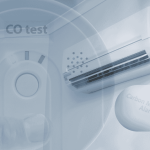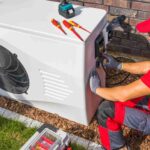We get it — you’re short on space, and the AC unit just won’t fit upright in your car or corner. But can you lay an air conditioner on its side and still expect it to work fine afterward? Yes, you can lay an air conditioner on its side temporarily, but only if it’s properly prepared, handled with care, and allowed to rest upright for at least 12–24 hours before use.
It’s not just about space — it’s about how air conditioners are designed to operate. Before making that tilt, we need to explore what happens inside the unit when it leaves its upright comfort zone.
AC units aren’t meant to lie flat like a suitcase. The internal components — especially the compressor, refrigerant lines, and drainage systems — are calibrated based on gravity. When you lay the unit on its side, you’re forcing the system to exist in a way it wasn’t engineered for.
Performance issues don’t always show up right away. But over time, if oil and refrigerant redistribute improperly, you’ll notice weak airflow, longer cooling times, strange noises, or even complete failure.
What Should You Consider Before Tipping an AC on Its Side?
Before you go horizontal, let’s break down the mechanics. These aren’t just hollow metal boxes — they’re delicate systems.
Why is the compressor particularly vulnerable during tipping?
The compressor relies on a lubricating oil pool to function properly. Laying the unit sideways can drain that oil away from where it’s needed. When restarted too soon, the compressor runs dry — and friction damage is nearly guaranteed.
How can refrigerant lines be impacted during side placement?
Bending, shaking, or improper angling of refrigerant lines while on the side can cause hairline cracks or leaks. And since refrigerant isn’t supposed to slosh around like soup in a bowl, cooling efficiency suffers.
How Do You Prepare an AC for Sideways Movement the Right Way?
If you’re absolutely out of options and must lay it on its side, don’t panic — just plan. Preparing the unit properly can help you avoid disaster later.
What steps should you take to drain and disconnect safely?
First, unplug the unit and let it cool for a few hours. Then drain any water from the condensation pan or reservoir. Moisture left inside can damage internal parts during movement — especially if the unit is tilted.
What’s the best way to protect refrigerant lines during handling?
Wrap refrigerant lines with foam insulation to provide cushioning and stabilization. Use soft ties to prevent them from shifting or kinking as the unit is moved sideways.
How do you prevent electrical issues while preparing the unit?
Use plastic wrap or a waterproof bag to cover the control panel and plug. Any contact with moisture — even from condensation — can corrode electrical boards and lead to power outages in the future.
What Is the Safe Way to Lay an AC on Its Side Temporarily?
Even with precautions, improper laying can be a disaster. Here’s how to do it right — if you absolutely must.
What side should you choose, and how should it be placed?
Check your manufacturer’s label — some models note the safe side for tilting. If there’s no guidance, avoid laying it on the compressor side. Always rest the unit on a padded, level surface and keep it as stable as possible.
Why should you use cushions and support padding underneath?
Cushions absorb movement, reduce vibration, and prevent denting or misalignment of internal components. A few inches of foam or a folded blanket can save you hundreds in repairs.
What are the most common mistakes people make during this process?
Trying to power the unit on too soon is a big one. You must let it rest upright — ideally for 12–24 hours — before turning it back on. Another mistake is skipping the drainage step or leaving the unit exposed to humidity during transport.
What Can Go Wrong If You Lay the AC Sideways Incorrectly?
These aren’t just theoretical problems. Let’s walk through what might happen if the job isn’t done right.
What kind of damage can occur to the compressor?
Without oil where it belongs, the compressor may overheat or seize up when powered on. Think of it like running a car without motor oil — metal scrapes metal, and then it’s game over.
How do refrigerant leaks impact your system long-term?
Leaks might be small at first, but they gradually reduce efficiency. If refrigerant escapes, your AC won’t cool properly — and you’ll need a licensed technician for diagnosis and recharge, which isn’t cheap.
Can electrical components be compromised during sideways movement?
Yes — especially if moisture seeps into the control board or motor. You might experience flickering displays, random shutdowns, or complete failure. Even a few drops of misplaced condensation can short-circuit delicate parts.
What Are Better Alternatives to Laying Your AC Flat?
If laying your air conditioner on its side doesn’t feel safe, you might want to explore vertical installation options instead — especially for tight window spaces or compact apartments. Not all AC models are designed for upright vertical mounting, so be sure to check your unit’s specifications.
How should you ideally transport the unit without laying it down?
Use an upright dolly or appliance cart. Secure the unit with straps and keep it vertical. If space is tight, try removing packaging or detachable side panels instead of tilting the whole unit.
What vertical installation options work for tight spaces?
Wall brackets and window frames can be modified to accommodate awkward dimensions. You can also explore slim-profile models or ductless mini-splits designed for limited clearance zones.
Can There Ever Be Benefits to Sideways Installation?
Let’s be honest — some people will still do it. So are there any upsides, if it’s done carefully and temporarily?
Can sideways positioning help with transport in tight vehicles?
In short-term scenarios like moving the unit in a sedan or storing it in a low-ceilinged space, laying it on the correct side with proper padding can prevent visible damage — but only if it’s powered off and rested upright before reuse.
Are there niche use-cases where sideways installs work?
In some RVs or tiny homes, custom side-mounted setups are used — but these require special mounts, airflow accommodations, and adjusted drainage angles. These are engineered solutions — not casual installations.
Can weather conditions affect the risks of sideways handling?
Yes. If it’s humid or rainy during your move, moisture can enter exposed areas and worsen the consequences of improper positioning. Always transport and store the unit in a dry, covered space.
Frequently Asked Questions (FAQs)
It’s not recommended. If you must, allow it to rest upright for 24 hours before powering it on.
Keep it upright when possible. If tilted, give it time to resettle before use.
Don’t plug it in right away. Set it upright for 12–24 hours to allow internal fluids to normalize.
Absolutely not. Mini-splits are engineered for vertical wall or ceiling mounting only.
Portable ACs may look more flexible, but they still contain refrigerant, coils, and internal drainage systems. Always drain the unit fully, keep it upright during use, and if laid down temporarily, let it sit upright for several hours before turning it back on.
Final Verdict on Laying an AC Unit on Its Side:
Here’s the truth: you can lay an air conditioner on its side — but that doesn’t mean you should, and it certainly doesn’t mean you can do so casually. If precautions aren’t followed, the risks are significant — from performance loss to total failure.
That said, if you prepare properly, move the unit with care, and give it time to recover before powering it back on, you can avoid the worst outcomes. But we always recommend keeping things upright — because, like your AC, your summer comfort depends on stability.









